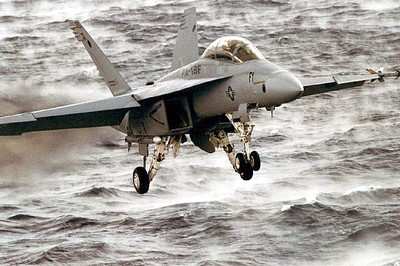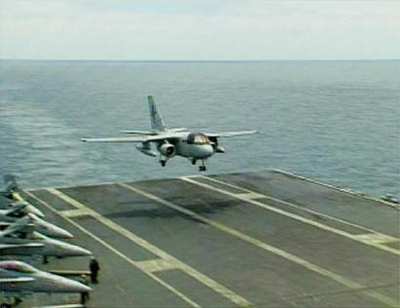Mon, Oct 24, 2011
Office Of Naval Research To Start Testing Next Year
Select pilots in early 2012 will commence testing new flight
control software, funded in part by the Office of Naval Research
(ONR), intended to facilitate aircraft landings on Navy carrier
decks with unprecedented accuracy. "The precision that we can bring
to carrier landings in the future will be substantial," said
Michael Deitchman, deputy chief of naval research for naval air
warfare and weapons. "The flight control algorithm has the
potential to alter the next 50 years of how pilots land on carrier
decks."

Navy and Marine Corps aviators conducting carrier landings today
line up with a moving flight deck in a complicated process. They
must constantly adjust their speed and manipulate the aircraft's
flight control surfaces-ailerons, rudders and elevators-to maintain
the proper glide path and alignment to the flight deck for an
arrested landing. Throughout their approach, pilots eye a set of
lights-known as the Fresnel lens-located on the left side of the
ship. It signals whether they are coming in too high or too
low.
The new algorithm embedded in the flight control software
augments the landing approach. Coupled with an experimental
shipboard light system called a Bedford Array and accompanying
cockpit heads-up display symbols, the software ties the movement of
the pilot's control stick directly to the aircraft's flight path.
Instead of constantly adjusting the plane's trajectory indirectly
through attitude changes, the pilot maneuvers the aircraft to
project a dotted green line in the heads-up display over a target
light shining in the landing area.
"It is almost like a video game," said James "Buddy" Denham, the
senior engineer who has been leading the research and development
efforts at Naval Air Systems Command. "You're tracking a shipboard
stabilized visual target with a flight path reference, and the
airplane knows what it needs to do to stay there."

ONR funded the project as part of its focus on sea-based
aviation, one of five Navy and Marine Corps research areas
designated as a national naval responsibility. The software has
been incorporated into an F/A-18 E/F Super Hornet flight simulator.
Researchers plan to conduct a study with U.S. Navy pilots and
British Royal Navy pilots who will fly the simulator to obtain data
on workload reduction and touchdown performance. Once the results
are tabulated, the engineers plan to integrate the refined
algorithm onto an actual aircraft for flight tests and
demonstrations.
If the tests are successful, the software could be integrated
aboard current and future aircraft to change the way carrier-based
aviators have landed aboard ships for more than half a
century-controlled crash landings. Increasing the precision of
landings will boost pilot safety and reduce training requirements
necessary to perfect carrier-landing skills. It could lower
aircraft life cycle costs by reducing maintenance and avoiding
repairs caused by hard landings.
More News
Say Altitude Used by ATC to ascertain an aircraft's specific altitude/flight level. When the aircraft is climbing or descending, the pilot should state the indicated altitude round>[...]
Aero Linx: European Air Law Association (EALA) EALA was established in 1988 with the aim to promote the study of European air law and to provide an open forum for those with an int>[...]
From 2023 (YouTube Version): The Life, Death, Life, Death, and Life of a Glorious Warbird In 1981, business-owner Jim Tobul and his father purchased a Chance-Vought F4U Corsair. Mo>[...]
Also: USCG Retires MH-65 Dolphins, Irish Aviation Authority, NATCA Warns FAA, Diamond DA42 AD This summer, history enthusiasts will have a unique opportunity to experience World Wa>[...]
Also: WACO Kitchen Bails, French SportPlane Mfr to FL, Dynon-Advance Flight Systems, Innovation Preview Bobby Bailey, a bit of a fixture in sport aviation circles for his work with>[...]
 ANN's Daily Aero-Term (05.01.24): Say Altitude
ANN's Daily Aero-Term (05.01.24): Say Altitude ANN's Daily Aero-Linx (05.01.24)
ANN's Daily Aero-Linx (05.01.24) Classic Aero-TV: Korean War Hero Twice Reborn
Classic Aero-TV: Korean War Hero Twice Reborn Airborne 04.29.24: EAA B-25 Rides, Textron 2024, G700 Deliveries
Airborne 04.29.24: EAA B-25 Rides, Textron 2024, G700 Deliveries Airborne Affordable Flyers 05.02.24: Bobby Bailey, SPRG Report Cards, Skydive!
Airborne Affordable Flyers 05.02.24: Bobby Bailey, SPRG Report Cards, Skydive!




